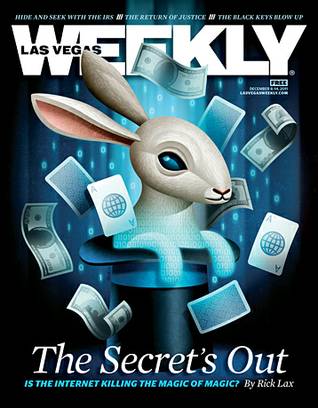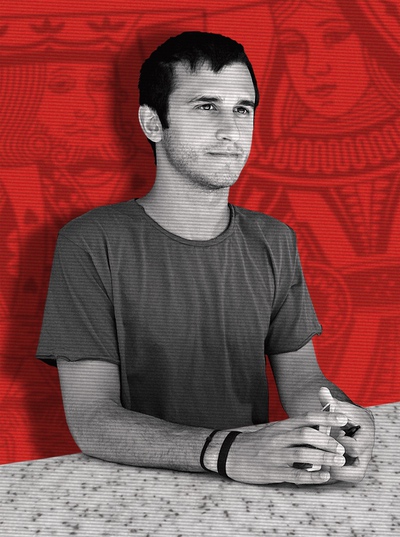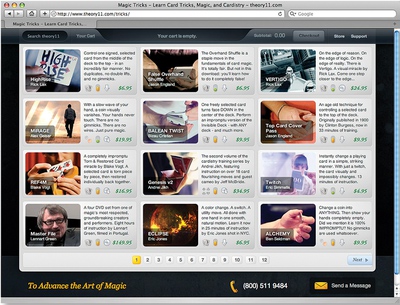
Thursday, Dec. 8, 2011 | midnight
Dai Vernon was a young father, and he needed money. He wasn’t broke, but he sure wasn’t rich. He wanted to perform magic, not get a proper job. And back in the 1930s, proper jobs were hard to come by, anyway.
In 1932, Vernon teamed up with fellow magician Faucett Ross, and together they penned a booklet of Vernon’s best tricks. Mind-blowing tricks. Tricks that still fool professional magicians today. Vernon wrote individual letters to 50 prospective buyers. He promised them he’d only sell 12 copies of the booklet—each typed by Ross’ girlfriend and hand-illustrated by Vernon himself. The selling price: $20—the equivalent of about $319 today.
Still, the book sold right away. Professional magicians and wealthy amateurs jumped at the chance to learn such well-guarded secrets.
It’s hard to imagine anything like that happening today. Now, magicians share secrets by way of instant download. Tricks are shot, produced and distributed by companies like Theory11, Ellusionist and VanishingInc. A good trick might sell a couple thousand copies. A great trick—Cell Phone in Balloon, for example—might sell tens of thousands. And some of those tens of thousands of buyers might log on to magic forums or chat rooms and expose a trick’s secret to hundreds of thousands more.
But if hundreds of thousands of people know a trick’s secret, is it really that great of a trick? Your answer to that question will almost certainly determine your answer to this one: Is the Internet revolutionizing magic … or killing it?
In the words that follow, I’ll introduce you to an Internet magic company CEO, an old-school grandmaster, a magic historian and a passionate amateur just back from Iraq. And I’ll pull back the curtain on a debate that’s ignited the magic community like flash paper.
Jonathan Bayme is one of the most influential guys in magic. He’s been one of the most influential guys in magic for just under a decade. He’s 23 years old. And he looks young for his age.
In the late ’90s and early 2000s, David Blaine’s TV specials hit the air, and suddenly, teenage boys across the country wanted to perform “street magic.” Jonathan Bayme—then a young teen himself—worked with Brad Christian at Ellusionist.com to capitalize on this trend. Christian had the instructional videos; Bayme had the tech savvy. So they worked together, selling the videos through the website. They sold a ton.
Four years ago, Bayme started his own company with David Copperfield producer Chris Kenner. Bayme lived in New York; Kenner lived in Las Vegas. Bayme would set his alarm for 2:55 a.m.—right before Copperfield’s MGM show let out at midnight, Vegas time—to field calls from Kenner.
The company that resulted from those calls, Theory11.com, sells magic props and DVDs. But mostly, it sells instant downloads. Theory11 is like iTunes for magic tricks. And just as iTunes and the music industry battle against filesharing, Theory11 fights against magicians who give away its secrets for free.
It’s easy to share a magic secret online. You can do it by video or by text. Few intellectual property protections (copyright, trademark, patent) are available to magicians, so legally there’s not much a master magician can do to stop a 14-year-old jackass in Sioux City from posting a YouTube video revealing a trick the master spent 30 years developing.
That sad truth begs the question, Why would anybody pay to learn a magic secret anymore?
“There’s a difference between learning how a magic trick works and learning why a magic trick works,” Bayme explains. “There’s a difference between teaching secrets and teaching magic. We teach the secret and the mechanics, but we also teach the history, the science and the psychology.”
Also, just because you know how a trick works doesn’t mean you’ll be able to perform it in a way that fools anyone. Most tricks have one big secret and five to 10 “subtleties” that work in conjunction with the big secret to produce a deceptive effect. Quick example: The Vanishing Quarter.
The Effect: You put a quarter in your fisted left hand and it disappears. The Secret: You don’t actually put the quarter in your left hand—you pretend to. The Subtleties: 1. As you move your right hand (which, unbeknownst to your spectator, still contains the quarter) away from your left, you stare at your empty left hand. That’s where you want your spectators looking, after all. 2. Move your left hand away from your body in an arc. That will draw further attention to it. (The eyes are drawn to objects moving nonlinearly because their ultimate destination is unclear.) 3. Swing your right hand down to your side naturally, as opposed to pulling it back slowly. 4. Subtly shift the fingers of your left hand, as if trying to reposition the coin. 5. Pause for five seconds before opening your left hand. You want to put temporal distance between the move (the false transfer) and the magical moment (the opening of the left hand).
Without those subtleties, the Vanishing Quarter trick sucks. With three of them, it’s decent. With all five, it’s great. But often, only the person who created the trick fully understands its subtleties and can share them in an intelligible way.
Of course, some magicians don’t care about subtleties, because they don’t care about performing tricks well. Magicians have a term for guys like this: bad magicians. Theory11.com can’t stop these bad magicians from watching and posting unauthorized explanation videos, but they can give ’em a run for their money. How? It all goes back to the story of the farmer and the leprechaun …
The farmer catches the leprechaun and makes him reveal the location of his gold pot. Turns out it’s buried beneath a tree in a massive forest. The farmer needs a shovel to dig it out. Before the farmer leaves the forest to get the shovel, he ties a red ribbon around the tree so he can find it when he returns. The farmer makes the leprechaun promise not to remove the ribbon. The farmer leaves, and when he returns with the shovel he discovers that every tree in the forest has a red ribbon tied to it.
That’s what Theory11 does—they tie red ribbons all over YouTube. They mobilize their customers to create and post fake explanation videos.
“Instead of vanishing a coin by sleight of hand,” Bayme explains, “a fake video might teach the method as using duct tape and tea tree oil from Poland. It’s meant to be fun and funny, but it makes it much harder for people to find the real methods.”
Let’s say you want to learn how to perform Theory11’s Vertigo, an effect in which the magician balances a whole deck of cards on the side of an empty card box. (The cards hang off the box’s edge, like a suspension bridge missing one side.) You search for “Vertigo revealed,” and Google directs you to a YouTube video of a bald guy explaining that the whole thing is done with Scotch tape. And then, a minute into the video, the guy tells you that he’s lying and pulls off his Mission Impossible-style mask and then—surprise!—it’s me.
Vertigo, you see, is my trick. I released it two months ago on Theory11.com. That’s what turned me on to the Internet magic debate in the first place. Or, more accurately, that’s what moved me from casual observer to interested player. And before the move, I never could have anticipated how many twists and turns, positives and negatives this game would have.
I’d published three tricks in Magic magazine last year, but Vertigo was my first commercial effort, so you can imagine my excitement on release night. But there was a hitch: Three hours before the trick came out, some guy in the Netherlands posted a YouTube video of himself performing, what appeared to be my trick. This note accompanying his online description—“This is not Rick Lax’s Vertigo from Theory11, which wasn’t even released yet when this was uploaded”—tells you a lot about his motives.
In the hours that followed Vertigo’s release, I received positive and negative comments—most of the latter from “followers” of the Netherlands guy. And by that, I mean people who subscribe to his YouTube channel.
I had a far more positive interaction with an Internet random named Andrew Sanchez. At the time, I knew Sanchez only from his Facebook profile picture, which shows him in combat fatigues, standing by a table of large bullets or tiny missiles—I can’t tell.
Sanchez’s command, the USS Carl Vinson (CVN-70), was the first to respond to the 2010 Haiti earthquake. Sanchez provided support to medical facilities that assisted men, women and children who had lost limbs. Then Sanchez deployed to Iraq. He can’t disclose the specifics of his mission, but he did say that he was close to the action.
Sanchez is a magician of 14 years. He performs in and around New York City, alongside his mentor Belinda Sinclair. Stage magic, street magic, private shows, cards, coins, mentalism—he does it all. And like any good magician, he’s always practicing. He’s always learning new tricks, and he wasn’t going to let something like a war get in the way.
“There are no local magic shops in Iraq, so my only avenue to keep up with the magic community is the Internet,” Sanchez says. “During a standby period in Kuwait—three days before flying into Iraq—I downloaded an instructional video.”
It was my second trick—a card control move called HighRise.
“Imagine working 12 hours a day, minimum, seven days a week for 11 months—you’re strained on all levels: emotionally, physically, spiritually,” Sanchez says of his time in Iraq. “A smile was rare to come by. So I broke out the cards. And people smiled more often and talked more freely. They spoke about magic and mystery and other things they’d been guarded about.”
Magic is the bestselling magic magazine in the world. It’s based in Las Vegas, and it’s edited by Stan Allen. Though he’s not a historian—this by Stan’s own admission—he, perhaps more than anyone else, has watched how the business of magic has transformed over the past few decades.
“There was a time when magic shops were on the second floor—inaccessible to the public. If you walked in the door, they’d say, ‘Who are you?’ and you’d say, ‘I’m a member of this IBM [International Brotherhood of Magicians] ring in that city.’ Then came the amateurization of art: The shops moved onto the boulevard and into the amusement parks. All of a sudden, magic was accessible to the masses.”
That newfound accessibility stirred up the same debate that’s going on now. “The old guard looked at the new shops and the new crop of magicians and said, ‘The sky is falling!’” Allen says. “And then the new crop grew up and they became the old guard. And now, they’re saying the same thing about the new new crop of magicians that was once said of them.”
Allen’s new new crop are the Internet magicians. “They’ve got a different approach and different goals. I’m not sure they even want to develop an act that they can perform live; they’re interested in making videos that go viral. From my viewpoint, it’s not a problem so much as it’s an interesting evolution.”
You can’t get more old-school than Johnny Thompson. The 77-year-old performs as the Great Tomsoni & Co., the “Co.” being his wife, Pam Hayes. Thompson dresses like Dracula and looks deadly serious … which makes his sight gags all the more hilarious. He’s an instructor, too. He’s consulted for Criss Angel, David Blaine and Penn & Teller, and he knows the business inside and out. He believes the best way to learn magic is from books, not videos.
“Those who learn from videos are best described as ‘parrots,’ in that they become copyists of the televised performer, in technique and in style,” Thompson says. “Someone who learns from books, on the other hand, has to adapt the material to their own technical skills, presentational abilities and style.”
When a rookie magician watches a master, he can’t help but copy. I’m not talking about intentional copying, like stealing the Amazing Johnathan’s one-liners. I mean unintentional, subconscious imitation.
For example, when David Copperfield makes a tiny object disappear, he has a particular way of opening his hand to show it’s empty. He does it one finger at a time, moving from the pinky to the forefinger. And before he extends the forefinger, he rubs it against his thumb for the briefest second.
And now, that’s how all magicians open their hands.
I don’t think everyone in the magic community sat down and decided to copy Copperfield’s hand-opening technique; I think they saw Copperfield on TV and figured that’s how magicians open their hands.
Ellusionist, Theory11, VanishingInc and all the other Internet magic companies do what they can to combat this parroting. The online teachers urge students to put their own spins on illusions. Few do. Unlike Thompson, who has a distinct performing style (Victor Borge, minus the piano), many magicians don’t care about developing a persona. They care about knowing secrets.
“It’s unfortunate,” Thompson says, “as a great many secrets are available to just about anyone who cares to investigate magic on the Internet. Of course, there’s still a close-knit group of us who strive to keep the secrets among those of us who are serious about the art. But it’s getting more and more difficult to do so, because so much wonderful material is available in print and on video.”
If Thompson and Allen are right, the Internet is filled with young magicians seeking out and exposing magic’s secrets with no intention of ever performing the tricks live. Why?
“There’s a growing trend among young magicians,” Thompson says. “They’re exposing magic secrets on the Internet just to prove—most probably to themselves—that they know how certain tricks are done. It’s sad that they feel the need to do so. It’s also something that I don’t understand, as ours is a profession that relies on the keeping of secrets.”
So are there any secrets left? Are any cats left in the magic bag? And if not, is all hope lost?
Maybe not. Maybe there were no cats in the bag to begin with …
Remember the Masked Magician, the guy who exposed all those magic tricks on Fox in the late ’90s? He caused a huge ruckus in the magic community. Magicians freaked out. They said this guy—his name’s Val Valentino, by the way—was killing magic. But you know what? He didn’t kill magic; he barely dented it.
Why? Here’s a theory: Secrets don’t matter as much as we think they do.
In the book Hiding the Elephant: How Magicians Invented the Impossible and Learned to Disappear, magic historian Jim Steinmeyer writes: “Magicians guard an empty safe. In fact, there are few secrets that they possess that are beyond the capacity of a high-school science class, little more complex than a rubber band, a square of mirrored glass or a length of thread. When an audience learns how it’s done, they quickly dismiss the art: ‘Is that all there is?’ The real art is how the rubber band is handled with the finesse of a jewel cutter, how a mirror is used or concealed precisely, how a masterful performer can hint at impossibilities that are consummated with only a piece of thread.”
Steinmeyer isn’t saying secrets are unimportant; he’s saying we overestimate their importance. By a factor of 10.
“There’s a fantasy that magicians have access to special secrets,” Steinmeyer tells me. “Magicians are self-deluded about this, too. But the truth is, a lot of magicians have little regard for the value of secrets. Magicians want the world to value their secrets highly, but they themselves don’t value the secrets. Magicians want the secrets on tap, and they feel like saying ‘I’m a magician’ entitles them. They resent the fact that Copperfield might have access to something they don’t.”
As Steinmeyer came to those realizations over the years, his feelings about magic DVDs and Internet downloads evolved: “I used to be sniffy about videos. But then I realized, I learned to cook from watching cooking shows. I saw the knife, I saw the onion, and I got better. If you watch people who are good at something, you get better. What’s so wrong with that?”
Not much, if you ask me. I’ve learned magic by book and I’ve learned magic by video, and video was the far more effective teaching tool. After all, magic is a visual art form, and visual arts are best learned visually.
As for the argument that the Internet is killing magic by facilitating unauthorized sharing, well, magicians have always shared secrets without authority.
Remember the story about Vernon’s $20 booklets? Here’s the part I didn’t tell you before: Immediately after Vernon sold the booklets, the buyers copied and resold them.
And yet, the magic went on.





Join the Discussion:
Check this out for a full explanation of our conversion to the LiveFyre commenting system and instructions on how to sign up for an account.
Full comments policy